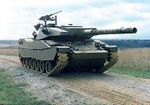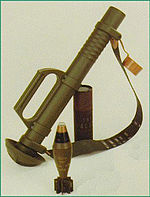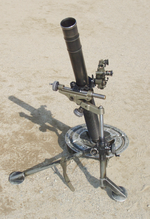Royal Onekawa-Nukanoa Army: Difference between revisions
| Line 435: | Line 435: | ||
| {{wpl|https://en.wikipedia.org/wiki/Bell_UH-1Y_Venom|Ua MH.6D}} | | {{wpl|https://en.wikipedia.org/wiki/Bell_UH-1Y_Venom|Ua MH.6D}} | ||
| [[File:UH-1Y_USS_San_Deigo.jpg|150px]] | | [[File:UH-1Y_USS_San_Deigo.jpg|150px]] | ||
| {{flag| | | {{flag|Belfras}} | ||
| Medium transport helicopter | | Medium transport helicopter | ||
| | | | ||
Revision as of 20:29, 19 April 2021
This article is incomplete because it is pending further input from participants, or it is a work-in-progress by one author. Please comment on this article's talk page to share your input, comments and questions. Note: To contribute to this article, you may need to seek help from the author(s) of this page. |
| Te Taua Roera o Onekawa-Nukanoa/Royal Onekawa-Nukanoa Army | |
|---|---|
| Active | 1896 - present |
| Country | Ngāti Onekawa-Nukanoa |
| Allegiance | Te Ope Manuka o Onekawa-Nukanoa/Royal Onekawa-Nukanoa Armed Forces |
| Branch | Army |
| Size | 92,000 (active), 33,000 (reserve) |
| Motto(s) | "Kia Kaha, Kia Toa" (Be Strong, Be Courageous) |
| Engagements | Onekawan War for Independence Onekawan Civil War of 1925 Monsoon War |
The Royal Onekawa-Nukanoa Army (Onekawan: Te Taua Roera o Onekawa-Nukanoa) is the land component of the Royal Onekawa-Nukanoa Armed Forces (Onekawa: Te Ope Manuka o Onekawa-Nukanoa) and comprised of 92,000 active personnel, with 33,000 reservist personnel and 3,700 civilians. It is charged with defending the soverignty and interests of Ngāti Onekawa-Nukanoa and its allies on land. The Royal Onekawa-Nukanoa Army can traces its lineage to the war-parties raised during and after the expulsion of Arthurista in 1896.
History
Structure and Organisation
Whilst the offical head of the Royal Onekawa-Nukanoa Army is Māori Kīngi Tama III Nukanoa in his role as Paramount Chief of Battle (Onekawan: Ariki Putakari) of the Royal Onekawa-Nukanoa Armed Forces, he invests his authority in the Chief of the Army (Onekawan: Rangitira Taua). At the moment this position is held by Atama Petera, who has responsibility for raising, training and sustaining the forces required to ensure the continued safety and protection of the sovereignty of Ngāti Onekawa-Nukanoa within the budget and parametres established by the civilian government.
The Royal Onekawa-Nukanoa Army is broken down into four main elements that report to the Chief of the Army; Army Force Command, Army Special Operations Command, Army Support Command and Army Reserve Command. Army Force Command is the primary combat command of the Royal Onekawa-Nukanoa Army, with both heavy mechanised divisions assigned too it. Army Special Operations Command is the other combat-focused command, responsible for both the Royal Onekawa-Nukanoa Parachute Rifles and Royal Onekawa-Nukanoa Naval Infantry brigades and the Royal Onekawa-Nukanoa Commandos. Army Suport Command is primarily an administrative command, responsible for the training and development in the Royal Onekawa-Nukanoa Army; whilst Army Reserve Command is responsible for the administration and maintenance of its three constituent reserve brigades.
Order of Battle
The Royal Onekawa-Nukanoa Army main combat force is comprised of eight active brigades; with three reserve brigades able to be called up if needed. Six of these brigades are intended for peer heavy conventional combined-arms warfare and heavily mechanised, these are assigned into two divisions; with two independent brigades that act as rapid reaction forces and equipped primarily as light infantry. The three reserve brigades can be raised and organised into their own independent division and are primarily a motorised force.
These mechanised brigades are either catergorised as cavalry or infantry brigades, in which the designation is determined by the ratio of armoured battalions to mechanised infantry battalions. Cavalry brigades have a 1:1 ratio of armoured battalions to mechanised infantry battalions, whilst infantry brigades have a 1:3 ratio for armoured to mechanised infantry battalions. Each division is comprised of one cavalry brigade and two mechanised infantry brigades.
The two independent brigades are the Royal Onekawa-Nukanoa Parachute Rifles and Royal Onekawa-Nukanoa Naval Infantry. Both of these units are intended primarily to operate as an rapid reactions forces focusing on deployment via either airborne/heliborne assaults or amphibious assaults respectively.
Equipment
Small Arms
| Model | Image | Origin | Type | Caliber | Details |
|---|---|---|---|---|---|
| Pistols | |||||
| SA.46AP | 
|
Semi-automatic pistol | 4.6x30mm | Standard service sidearm. | |
| SA.9 | 
|
Semi-automatic pistol | 9x19mm | Former standard service sidearm, now in storage for use by reserve forces. | |
| Submachine Guns | |||||
| STG.11AP | 
|
Submachine gun | 4.6x30mm | Updated development of SMG.11, standard service firearm to vehicle crews, support personnel and special forces. | |
| SMG.11 | 
|
Submachine gun | 9x19mm | Former standard service firearm to vehicle crew, support personnel and special forces. Now in storage. | |
| SMG.7 | 
|
Submachine gun | 9x19mm | Former standard service firearm to vehicle crew, support personnel and special forces. Now in storage. | |
| Rifles/Carbines | |||||
| AR.17M | Assault rifle | 5.56x45mm | Standard service rifle | ||
| AR.4 | 
|
Assault rifle | 5.56x45mm | Former standard service rifle, now in storage. | |
| IR.3R | 
|
Battle rifle | 7.62x51mm | Former standard service rifle, now in storage for use by reserve forces. | |
| Shotguns | |||||
| SG.5 | Semi-automatic shotgun | 12 Gauge | Standard service shotgun. | ||
| Precision Rifles | |||||
| MR.21 | 
|
Marksman rifle | 7.62x51mm | Standard service marksman rifle. | |
| PR.9 | Sniper Rifle | .338 | Standard service sniper rifle. | ||
| PR.7 | Sniper Rifle | 7.62x51mm | Former standard service sniper rifle, remains in limited service. | ||
| Machine Guns | |||||
| LMG.22 | 
|
Light machine gun | 7.62x51mm | Standard service light machine gun. | |
| GMG.15 | 
|
General purpose machine gun | 7.62x51mm | Standard service general-purpose machine gun for the primarily for the Royal Onekawa-Nukanoa Parachute Rifles and Royal Onekawa-Nukanoa Naval Infantry. | |
| HMG.2 | 
|
Heavy machine gun | 12.7x99mm | Standard service heavy machine gun. | |
Armoured Fighting Vehicles
| Name | Photo | Origin | Role | Version | Number | Comment |
|---|---|---|---|---|---|---|
| Tanks | ||||||
| Whakatōpū Main Battle Tank | 
|
Main battle tank | 482 | Standard service main battle tank. | ||
| Hākuturi Main Battle Tank | 
|
Main battle tank | 255 in storage | Former stand service main battle tank, now in storage. | ||
| Weka Light Tank | 
|
Light tank | 44 | Standard service light tank for the Royal Onekawa-Nukanoa Parachute Rifles. | ||
| Infantry Fighting Vehicles | ||||||
| Honu II Infantry Vehicle Vehicle | 
|
Infantry fighting vehicle | 912 | Standard service infantry fighting vehicle. | ||
| Honu I Infantry Vehicle Vehicle | 
|
Infantry fighting vehicle | 414 | Former standard service infantry fighting vehicle, now in storage. | ||
| Light Armoured Vehicles | ||||||
| Kaponga Infantry Mobility Vehicle | 
|
Infantry mobility vehicle | ||||
Artillery
| Name | Photo | Origin | Role | Version | Number | Comment |
|---|---|---|---|---|---|---|
| Mortars | ||||||
| CM.7 | 
|
Commando mortar | Standard service commando mortar for the Royal Onekawa-Nukanoa Parachute Rifles and Royal Onekawa-Nukanoa Naval Infantry. | |||
| M.6 | 
|
Medium mortar | Standard service mortar | |||
| HM.4 | 
|
Heavy mortar | Standard service heavy mortar for the Royal Onekawa-Nukanoa Parachute Rifles and Royal Onekawa-Nukanoa Naval Infantry | |||
| Towed guns | ||||||
| TLH.6 | 
|
105mm field artillery | Standard service towed light howitzer, sees limited service. | |||
| TMH.8 | 
|
155mm field gun | Former standard service towed medium howitzer, serves primarily with reserve forces | |||
| TMH.9 | 
|
155mm field gun | Standard service towed medium howitzer. | |||
| Self-propelled | ||||||
| SPH.6 | 
|
155mm self-propelled gun | Standard service self-propelled howitzer. | |||
| SPH.5 | 
|
155mm self-propelled gun | Former standard service self-propelled howitzer, now in storage. | |||
| RA.4 | 
|
Self-propelled MLRS | Standard service rocket artillery. | |||
Aircraft
| Name | Image | Origin | Type/Variants | Number in Service | Details | |
|---|---|---|---|---|---|---|
| Helicopters | ||||||
| Urupuhau MH.8A | 
|
Multirole helicopter | Standard service transport helicopter, capable of fulfilling a variety of different utility roles. | |||
| Naenae LH.11D | 
|
Light multi-mission helicopter | Standard service light utility helicopter, capable of fulfilling a variety of different roles. | |||
| Hukātara AH.9B | 
|
Attack helicopter | Standard service attack helicopter. | |||
| Rorohū HH.9K | 
|
Heavy transport multirole helicopter | Standard service heavy-lift helicopter. | |||
| Ua MH.6D | 
|
Medium transport helicopter | Former standard service medium transport helicopter, now in storage. | |||